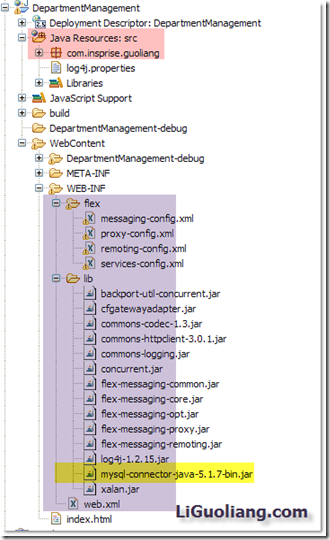MySql:#1467 – Failed to read auto-increment value from storage engine
Categories: Database; Tagged with: #1467 • MySQL; @ March 14th, 2010 23:31某日, mySql(5.1.30-community)如此报错, 用phpMyAdmin强行插入, 亦是如此:
但如直接指定Auto-Increment的 Field, 就可顺利插入.
解决:
修改该自增Filed的属性, 先将其自增属性点掉:
保存后, 再点选其自增, 再保存, 问题暂时解决.
英文水平有限, 暂不深究….
使用MysqlWorkbench 生成mysql反向工程
Categories: Database; Tagged with: MySQL • MySQLWorkBench • MySQL反向工程; @ April 1st, 2009 14:44首先将MySQL数据库导出, 可使用PhpMyAdmin等工具,
打开WorkBench, File > import > Reverse Enginner MySQL Create Script…
选择导出的mysql文件, 确定即可.
SQL Reserved Words Checker – SQL保留字查询
Categories: Database; Tagged with: MySQL • SQL; @ March 29th, 2009 11:21支持数据库:
SQL Server, MySQL, PostgreSQL, Oracle, DB2, ANSI SQL, ODBC
地址:http://www.petefreitag.com/tools/sql_reserved_words_checker/
演示:
Flex BlazeDS Java JDBC MySql 快速配置
Categories: Flex • Java; Tagged with: ActionScript • BlazeDS • Flex • Java • JDBC • MySQL; @ February 20th, 2009 16:481. Java – JDBC – MySql
1. 装好MySql, 启动服务.
2. 将mysql-connector-java-5.1.7-bin.jar 拖入WEB-INF/lib下.
搞定.
2. Java端BlazeDS配置
1. Java端:
将BlazeDS压缩包内的WEB-INF里面的东西拷贝工程内的WEB-INF下的相应位置中.[ Flex目录下有四个xml配置文件, lib下是需要使用的jar] 包括web.xm
2. 配置services-config.xml中channels标签中的内容:
false
true
4
其中, http://localhost:8080/DepartmentManagement/ 是该Web工程的地址 [可在web-content下建立一空index.html, 运行后查看地址便可]
3. 编写Java类, 并配置remoting-config.xml文件的<service>标签下, 增加服务, 如下:
com.insprise.guoliang.DepartmentManagement
3. Flex端建立工程
1. 建立 Flex与Java通信载体RemoteObject
为方便在整个工程中使用, 可建立一个Singleton – 关于AS中的Singleton可见: http://liguoliang.com/2008/10/128/
在该类中建立RemoteObject.
首先需要确定RemoteObject的destination, 在本例中 为”DepartmentManagement”; – 在remoting-config.xml中已配置.
其次需要确定ro的channel – 本例中为:”http://localhost:8080/DepartmentManagement/messagebroker/amf"; - 在services-config.xml中已配置
代码:
public static const DEFAULT_DEST:String = "DepartmentManagement";
public static const DEFAULT_CHANNEL_URL:String = "http://localhost:8080/DepartmentManagement/messagebroker/amf";
private static var _ro:RemoteObject;
/**
* Constractor - Singleton
*/
public function AppContext():void {
throw new Error("AppContext is Singleton!");
}
/**
* Get RemoteObject
*/
public static function getRemoteObject():RemoteObject {
if(_ro == null) {
_ro = createRemoteObject(DEFAULT_DEST, DEFAULT_CHANNEL_URL);
}
return _ro;
}
/**
* Constructs a new remote object with new channel.
* @param roDestination Destination of the RemoteObject; should match a destination name in the services-config.xml file.
* @param channelURI the URI used to create the whole endpoint URI for this channel; this uri can be relative uri (to the folder containing the SWF).
* @param channelId the id of the channel, if set to null, a random Id will be assigned.
*/
protected static function createRemoteObject(roDestination:String, channelURI:String, channelId:String = null):RemoteObject {
var channelSet:ChannelSet = new ChannelSet();
var channel:AMFChannel = new AMFChannel(channelId == null ? "channel-" : channelId, channelURI); //Create new Channel
channelSet.addChannel(channel);
var ro:RemoteObject = new RemoteObject(roDestination);
ro.channelSet = channelSet;
return ro;
}
4 配置完成,.
在Java端建立相关的Class,
启动服务器.
在Flex端通过 Appcontext.getRemoteObject.getOperation(“方法名称”)来调用服务器端方法.
具体实例:
Java端的Class – 通过JDBC 读取 MySql中数据:
/**
* Load all Department and return an ArrayList
* @return
*/
public ArrayList loadDepartments() {
ArrayList departmentsAL = new ArrayList();
log.info("Loading Departments...");
try {
//Get Connection
Connection conn = JdbcUtilities.getConnection();
//Create statement
String sql = " SELECT * FROM Department d ORDER BY d.Department_ID";
PreparedStatement ps = conn.prepareStatement(sql);
ResultSet res = ps.executeQuery();
log.debug("Exectuing: " + sql);
while (res.next()) {
int id = res.getInt("Department_ID");
String name = res.getString("name");
Department dp = new Department();
dp.setId(id);
dp.setName(name);
departmentsAL.add(dp);
log.debug("从数据库获得部门: " + dp);
}
JdbcUtilities.closeConn(res, ps, conn);
log.info("加载部门信息结束, 共加载部门: " + departmentsAL.size());
} catch (Exception e) {
log.error("SQL Error", e);
throw new Error(e);
}
return departmentsAL;
}
Flex端的代码:
/**
* Load the Department's Employee
*/
private var op:AbstractOperation;
public function loadEmployees():void {
op = AppContext.getRemoteObject().getOperation("loadEmployees"); //获得Operation
op.arguments = [id]; //设定参数
var at:AsyncToken = op.send(); //Send
at.addResponder(this); //为本实例增加responder
}
Flex端responder剩余代码见:http://liguoliang.com/2009/02/777/
运行Flex工程, Flex取得RemoteObject, 然后通过channel建立到destination的连接,由Java读取数据库中信息, 并返回给Flex.
JDBC中Preparedstatement使用小结 及JDBC插入数据后获得Last insert ID
Categories: Java; Tagged with: Java • JDBC • MySQL • PreparedStatement; @ February 19th, 2009 10:20编写SQL语句, 尤其是要插入多个Filed时, 是一件非常BT的事情, 至少让我很不爽, 使用preparedstatement可以使代码变得更优雅一些, 虽然会有些长, 但会更条理, 而且preparedstatement更高于SQL语句 – 相对来说不太容易随着数据库版本改变而变动. 另外preparedstatement效率更高, 安全性更好
下面是恐怖的SQL:
Statement statement = (Statement) conn.createStatement();
String sql = "INSERT INTO `DEP`.`employee` " +
"( `name` , `age` , `address` , `isMale` , `level` , `Department_ID` ) " +
"VALUES (" +
"'" + emp.getName() + "', " +
emp.getAge() + ", " +
JdbcUtilities.getSqlForString(emp.getAddress()) + ", " +
emp.getIsMale() + ", " +
emp.getLevel() + ", " +
emp.getDepartment_ID() + ");"
;
log.debug("Executing sql :" + sql);
statement.executeUpdate(sql);
ResultSet rs = statement.executeQuery("SELECT last_insert_id();");// .execute("SELECT last_insert_id();");
if(rs.next()) {
System.out.println(rs.getInt("1"));
}
这里是使用PreparedStatement后的语句:
String psql = "INSERT INTO Employee (name, age, address, isMale, level, Department_ID) VALUES (?, ?, ?, ?, ?, ?)";
PreparedStatement ps = conn.prepareStatement(psql,Statement.RETURN_GENERATED_KEYS);
ps.setString(1, emp.getName());
ps.setInt(2, emp.getAge());
ps.setString(3, emp.getAddress());
ps.setInt(4, emp.getIsMale());
ps.setInt(5, emp.getLevel());
ps.setInt(6, emp.getDepartment_ID());
ps.executeUpdate();
ResultSet keys = ps.getGeneratedKeys(); // equivalent to "SELECT last_insert_id();"
if(keys.next()) {
System.out.println(keys.getInt(1));
}
PreparedStatement的使用步骤:
-
声明 PreparedStatement。
PreparedStatement prepStmt;
-
将一条 SQL 语句指派给 PreparedStatement 对象。
prepStmt = conn.prepareStatement( "INSERT INTO MyTable(MyColumn) values (?)");
-
为该语句指派输入参数值。
以下代码显示一个字符串参数。
String newValue; // assign value prepStmt.setStringParameter(1, newValue);
-
执行该语句。
返回值表示受该语句影响的行数。
long rowsInserted = prepStmt.executeStatement();
-
如果禁用了 [自动提交],请提交更改。
conn.commit();
获得组后插入的ID, 在上面代码中已经包括.




